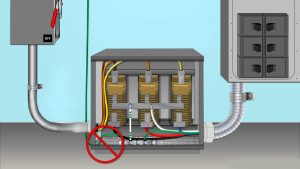How are 2023 NEC grounding electrode conductor rules affecting transformer installations?
 Overview
Overview
All transformers create heat as a function of their operation. Because of this, manufacturers include ventilation openings in the transformer enclosure. These openings aid with cooling and the safe operation of the equipment under any condition that may be encountered, including normal and abnormal operating conditions. Most of these transformers are installed as a separately derived system, which requires connection to the grounding electrode system. In the past, it has been common practice to route the grounding conductor through the existing ventilation openings on the transformer for ease-of-access. The 2023 NEC has added new subsection 250.64(G), which now prohibits this previously common practice for any equipment that includes ventilation openings.
Applying the 2023 Code
The 2023 NEC has added new Subsection 250.64(G), which prohibits the routing of grounding electrode conductors through the ventilation openings in equipment enclosures. Ventilation openings are included with equipment for cooling use, not conductor routing. Furthermore, the equipment’s listing status depends on the ventilation openings not being obstructed. When grounding electrode conductors occupy the same space airflow can be impeded, causing undesirable heating effects. Because of this, the ventilation openings cannot be used for the routing of grounding electrode conductors. Moving forward, the electrical professional will need to be watch out for installations that do not align with this new requirement. An alternative means of installation could be as simple as drilling an additional hole in the sidewall of the equipment, installing a bushing, and routing the grounding electrode conductor(s) through a dedicated opening.
What’s New for the 2023 NEC?
2020 NEC
In the 2020 NEC Section 250.64(G) did not exist.
2023 NEC
In the 2023 NEC Section 250.64(G) reads as follows:
(G) Enclosures with Ventilation Openings.
Grounding electrode conductors shall not be installed through a ventilation opening of an enclosure.
